Internet of Things for Optical Sensors
Info: 7465 words (30 pages) Dissertation
Published: 11th Dec 2019
Tagged: Internet of Things
PROJECT REPORT
ON
INTERNET OF THINGS
| S.NO | TOPIC NAME | PAGE NUMBER |
| 1 | INTRODUCTION
1.1 IMPLICATION OF IOT 1.2 ARCHITECTURE 1.3 KEY TECHNOLOGY OF THINGS |
5-9
6 6-8 8-9 |
| 2 | SENSING TECHNOLOGY
2.1 OPTICAL FIBER SENSOR 2.1.1 INTRINSIC SENSORS 2.1.2 EXTRINSIC SENORS 2.2 TYPES OF SENSORS IN IOT 2.2.1 PRESSURE SENSOR 2.2.2 TEMPERATURE SENSOR 2.2.3 PROXIMITY SENSOR 2.2.4 RADIO FREQUENCY IDENTIFICATION 2.3 APPLICATIONS OF SENSORS IN IOT 2.3.1 DIGITAL OIL FIELD 2.3.2 AUTOMOBILE INDUSTRY 2.3.3 HIGH VOLTAGE TRANSMISSION LINE 2.3.4 SMART PARKING 2.3.5 SMART WATER SUPPLY 2.3.6 SMART GRIDS 2.3.7 INTELLIGENT COMMUNITY SECURITY SYSTEM |
9-
9-12 9-11 11-12 13-14 13 13 13 13-14 14-17 14 14 15 15-16 16 16 16-17 |
| 3 | CHALLENGES | 17-20 |
| 4 | FUTURE WORK AND CONCLUSION | 20-21 |
INDEX
TABLE OF FIGURES
Fig. 1 Implication of IOT …………………………………………………………………6
Fig. 2 Architecture of IOT…………………………………………………………………7
Fig. 3 Intrinsic optical sensor.….…………………………………………………………10
Fig.4 Extrinsic optical sensor………………………………………………………………12
Fig.5 Smart parking…….…. ………………………………………………………….….16
Fig.6 Community system………………………………………………………………….17
Fig.7 Proposed technologies…………………………………………………………..……21
ABSTRACT
For the communication domain, the growth in the IOT (the Internet of Things) industry has become the new trade mark. As the developments in the technology of the IOT are done in the fiber-optical sensor, the fiber-optical IOT holds a good development prospect and the combination both of these things arises a question for discussion, and in the IOT network the interrelated physical objects (so called “things”) are there, such as electronic devices, vehicles, home appliances, buildings, and same like these that can exchange and collect data by using one another with connected electronics, sensors, software, over the whole Internet. It helps to extend the Internet connectivity beyond the traditional devices like smartphones and tablets, laptop computers and desktops computers to a wide range of devices and the things which are used in everyday life that uses embedded technologies for the communication and interact with the other devices, all with the help of the Internet. In this report, the IOT was introduced as the key technology by many articles for optical sensors, and then applications. There are many specific applications are of IOT with fiber optic sensing system in it to be used in the mine safety based on the fiber-optical IOT.
1. INTODUCTION
The Internet of Things (IoT) proposes an idea of a future Internet where users, computing systems, and everyday things possessing actuating and sensing capabilities collaborate with extraordinary convenience and economical advantages. As per the fixed protocol of the computer internet through radio frequency identification, global positioning systems, infrared sensors, laser sensors and other information device, everything relates to internet, information exchange and communication can be done in entire network. The Internet is main source and foundation, but to expand and extend the Internet, it is necessary to connect it with variety of other networks to communicate globally with multi-networks. In recent years, optical fiber sensing technology is being developed very rapidly and has been useful in variety of fields like health care, chemicals, aerospace, environment, energy generation, etc. Optical fiber sensing technology has remote transmission, multiplexing capabilities, multi-parameter, real-time online transmission, intrinsic safety, lesser interference, etc. as compared to other traditional technologies. This technology can enhance the security and production automation of existing network. With the developments in recent years, many features of fiber for active and passive devices have been provided in international community. These features are keep improving by the time and the price is reduced with improvement, therefore the fiber sensor technology is strongly promoted in the fields of information transmission and sensing, and it provides huge amount of applications. Due to large bandwidth and high speed transmission, the fiber optic communication network is suitable for long distant transmission and can carry large amount of data. It is very much compatible for expanding Internet of things (IOT). In the bottom layer of IOT, a huge variety of sensors are used. The increase in development of the optical fiber sensor technology has attained a great achievement in large number of fields, e.g. laser technology, fiber optic technology and optical detection technology. In the promotion of development of IOT, optical fiber sensor technology has great advantages. It is being used in many fields of people’s lives and national economy. Apart from advantages of IoTs, there are some challenges to the Iot as well.
1.1 IMPLICATION OF THE CONCEPT OF IOT
The three aspects of the international recognition of IOT are thing to thing (T2T), human to thing (H2T) and human to human (H2H). It links the Internet and sensor networks together in the traditional way so that it can keep all things connected. Therefore, network in the form of IOT can handle any situation of wisdom as the peripheral nerves can touch any object and person by linking through the intermediate links to be a whole. It is shown in figure 1. There are three characteristics for this application. First is the full-perception. It is the use of the available means for dynamic things to achieve real-time collection at any time. Reliable transmission is the second characteristic. Information is transferred on the Internet in real time through a variety of communication networks. Third characteristic is intelligent processing. It processes massive data and information to control the implementation intelligently by making use of cloud computing and other intelligent computing analyze.
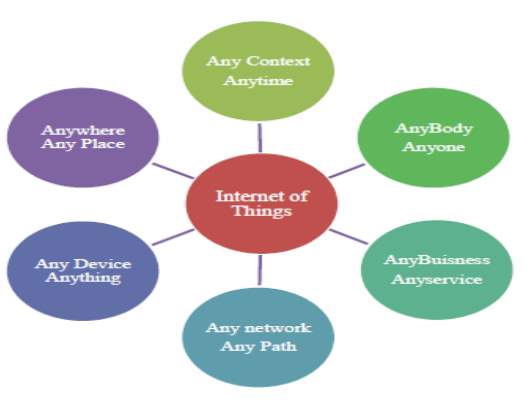
Fig.1: Implication of Iot
1.2 ARCHITECTURE
Internet of things is defined by infrared censors, laser sensors, radio frequency identification and many more sensing devices, according to the fixed protocols. For everything, which is connected to the Internet, Communication and information exchange realized to get intelligent positioning, tracking, identification, monitoring and management in a network.
In sensing layer, there are various types of control modules and acquisitions, such as sensor networks, RFID tags and readers, sound, temperature, vibration sensor, a variety of terminals, two-dimensional bar code. The perception layer is used to collect the underlying information; the device control functions and data acquisitions are completed IOT applications. These are the basis of Internet of things’ applications and development. In sensing layer, there are mainly data acquisition and a short distance transmission. All the information and the data are sensed and collected with the help of sensing devices. After that, with the help of bus or short distance wireless medium, all the information is fed to the upper layer.
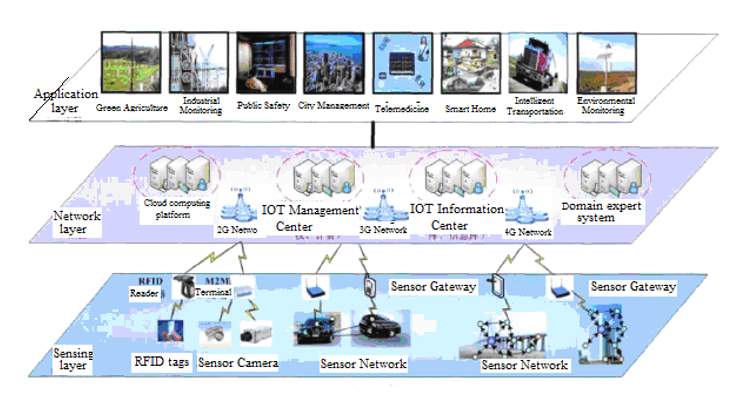
Fig. 2: Architecture of IOT
Network layer is designed according to the existing networks. Integrations and expansions are made in the existing networks. Multiple heterogeneous networks exist in the formation of complete network include several organic integration networks. Various functions of data transmission are assumed previously. The data is transmitted in the perceived layer with high security, accessibility, high reliability especially for long distance transmission. Many parts of perception of data processing and management are included in perception layer.
Application layer is the main part and driving force of the network. It is the main purpose of the development of things. The perception and transmitted information is analyzed and processed in the application layer. Other functions of application layer are intelligent management, the correct control and decision-making, making of application and services. The problems regarding human machine interface and information processing are solved by this layer. Mainly, various information systems process the data received from various network layers, and then it connects with people through the devices. This layer has further divided into two sub parts: the application layer and the terminal devices layer.
1.3 THE KEY TECHNOLOGY OF THINGS
IOT comprises of information technology, communication systems, sensing technology (sensors) and automation and other technologies, IOT technology is divided into three parts as application layer, network layer and perception layer. As per architecture, the techniques like the data mining, cloud computing, the massive data storage, resource virtualization, data sharing, software architecture, etc. are considered at the application layer. Whereas the technologies like sensor technology, wireless communication networks, self-organizing networks, RFID technology and embedded systems are included in the perception layer. While the network layer mainly consists of M2M, radio technology and network context-aware technology.
The perception layer technology includes data collection techniques, short distance communication and collaborative information processing technology in the perception layer. The sensor can sense the measured information in the data acquisition techniques and the detected information can be transformed into electrical signal or other forms of the vital information as per some rules, which is the output meeting the requirements of the information transmission, recording, processing, display, storage and control systems. By the usage of radio frequency signals and space electromagnetic coupling, RFID technology accomplishes the non-contact transmission of information and the object is identified by the transmitted information. RFID technology is a one of the short-range communications technology and used for device identification. For the small businesses that is for short-range communication, a common ZigBee technology. Moreover, low-power wireless transmission technology is suitable for small businesses for carrying a data traffic.
We mainly consider the networking and communications technology at the network layer. Through ubiquitous connectivity features, network is infrastructure of the IOT information transmission and support services. Perceptive Informatics is achieved and transferred in high reliability and high security.
Our main consideration is heterogeneous network convergence technology which is a variety of wireless and wired networks while considering the conventional mobile communication networks, Internet and another technology. As the information silos are omitted and a global information is integrated, so, these are gradually fused to form a unified information exchange network. In the application layer, there is massive computing and processing sensory information when comparing with the general network. A major problem is considered after the application of large-scale development of things, efficient storage, data fusion, semantic analysis, parallel processing, data mining and other functions which are recognised in the mass information.
Due to the openness, inclusiveness and autonomy, IOT public administration and support technology is the very imperative issue, which are taken into consideration during the construction of things, therefore we must study the new management model and key technologies of IOT. Also, security technology is more optimized to ensure the normal development of IOT.
2. SENSING TECHNOLOGY
2.1 OPTICAL FIBER SENSOR
A sensor which uses fiber as a sensing element (“intrinsic sensors”), or as a means of relaying signals form a distant sensor which are again processed by the electronics (“extrinsic sensors”). In remote sensing fiber has a lot of uses. Fiber may be used because it is smaller in size, or because there is no need of any electric power at the remote location, or because many channels can be multiplexed along the fiber length by using various multiplexers which shifts the wavelength of light for each sensor, or by sensing the delay in time as the light passes through each sensor along the fiber. Time-domain reflectometer is used to determine the time delay and the shift in wavelength can be determine by using an instrument implementing optical frequency domain reflectometry.
The other benefit of fiber optic sensors is that these are very immune to electromagnetic interference, there for they can be used at places of high electricity and in high flammable places like jet fuel etc. These fiber optics are designed in a way so that they can withstand higher temperatures as well. Along with all these, fiber optic sensors are also light in weight, low in cost, high sensitivity, long sensing distance and low latency. Mostly fiber optic sensors are classified in two categories: Intrinsic and Extrinsic sensors.
2.1.1 INTRINSIC SENSORS: In this category, all the process of sensing take place inside the fiber itself. The properties of the optical fiber are totally responsible for conversion of an environmental action into a light beam modulation passing through it. Optical fiber can be used to sense various things like strain, temperature, pressure and many other quantities by modifying fiber to measure the quantity which modulates the intensity, phase, wavelength, polarization or transit time of light in the fiber. Beside all the features, the most useful feature of intrinsic sensors is that it gives distributed sensing over long distances. This type of sensors which vary the light intensity are very simple because only simple source and simple detectors are required in them.
To measure temperature, a fiber that has evanescent loss that varies with temperature is needed, or temperature can also be measured by analyzing Rayleigh Scattering, Brillouin Scattering or the Raman scattering in the fiber. The sensors which measure angles can be based on Sagnac effect. To sense electrical voltage, nonlinear optical effects in a specially doped fiber are measured, which alter the light polarization as a voltage or electric field function.
There are some special fibers like long-period fiber grating (LPG) fibers which can be used to recognize the direction.
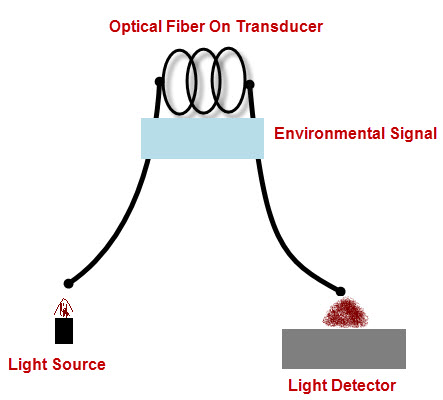
Fig. 3: Intrinsic optical sensor
Fig (3) shows that one or more physical properties of fiber in intrinsic optic fiber sensor undergo a change. When perturbations acts on the fiber then the fiber in turn changes some of the characteristics of the light inside the fiber. A fiber optic sensor can be classified as an intensity, a frequency, a phase or a polarization sensor based on the modulation and demodulation process or operating principle. External perturbations are responsible for changes of all the parameters. Therefore, to sense the external perturbations, all the parameters and the changes in them can be detected.
Optical fibers are also used for sonar and seismic applications as hydrophones. In recent years, hydrophone systems have been developed with more than one hundred senores per optical fiber cable. These systems are used by navies of few countries and by the oil industries as well. Two types of hydrophones, bottom-mounted and towed streamer systems are in common. A laser microphone to use with the optical fiber is developed by Sennheiser, a German company.
Fiber optic based headphone and fiber-optic microphone are used in the zones which has high electrical or magnetic fields, such as communication between the team during MRI-guided surgery operating on a patient in a magnetic resonance imaging (MRI) machine.
For downhole measurement in oil wells, optical fiber sensors are used for temperature and pressure measurement. They are well suited for this environment because the fibre optic sensors functions at the temperatures that are too high for semiconductor sensors that is distributed temperature sensing.
Optical fibers, which are used in the Boeing 767 and in some car models (for navigation purposes) can be made into interferometric sensors such as fiber optic gyroscopes. Hydrogen sensors are also made by using them.
Fiber-optic sensors have been established with the help of fiber Bragg gratings to measure co-located temperature and strain simultaneously with very high accuracy. This is mainly beneficial when gaining the information from small or complex structures. By using an optical fiber cable, Fiber Bragg grating sensors can be interrogated 250 km away from the monitoring station because they are particularly well suited for remote monitoring. Strain and temperature over large distances (20–120 kilometers) can be detected cy using the Brillouin scattering effects.
2.1.2 EXTRINSIC OPTICAL SENSORS: The information is carried through fiber that shows the way to a black box located in the extrinsic optical sensors figure 4. A light signal is generated by this sensor depending upon the arrived information at the black box. The black box usually contain glass, mirrors or any other mechanisms that reflect or generate optical signal. Normally in a multimode optical fiber cable, an electronic sensor is connected to the transmitter to transmit modulated light from a fiber or s non-fiber optical sensor. as shown in the figure, in extrinsic optical sensor, the light is carried by a fiber to and from an external optical source. At this place, all the process of sensing takes place. The fiber just acts as a carrier to carry the light to the sensing location in this case.
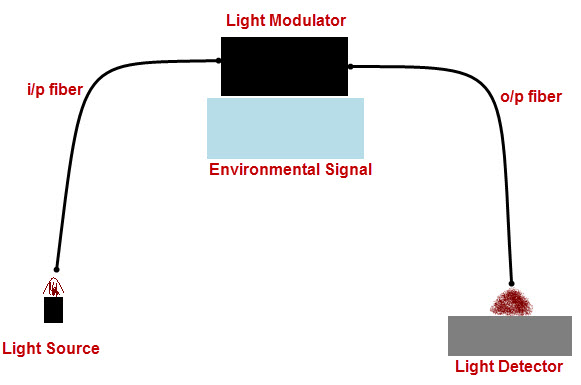
Fig. 4: Extrinsic optical sensors
Optical technologies can be used to generate optical data in IOT network besides transporting and routing data in case of optical imaging and sensing.
There are several examples such as in the measurement of temperature inside the engines of aircraft jets with the help of fiber to transmit radiation to a radiation measuring pyrometer which is located outside that jet engine. These extrinsic sensors can also be used in temperature measurement in the electrical transformers, where all other methods of measurement are impossible to implement because of the extreme electromagnetic fields present in the electrical transformers.
In case of extrinsic optical sensors, the chances of noise are very much less, therefore it provides excellent immunity to measurement of signals against noise corruption. But, there are many cases in which electric signals need to convert into optical signals for use with optical fiber. For example, the changes in temperature are translated in resistance changes in case of platinum resistance thermometer (PRT). It is must for the PRT to have an electrical power supply. At the output, then the modulated voltage level can be injected into the fiber with a normal transmitter. due to this the measurement process is complicated and this means that low voltage power cables need to be routed to the transducer. extrinsic optical sensors are used to measure a lot of things such as rotation, vibration, velocity, temperature, displacement, torque and acceleration. The major benefit of these sensors is this that they can reach at the places where other sensors cannot perform their functions.
2.2 TYPES OF OPTICAL SENSORS IN IOT
2.2.1 PRESSURE SENSOR: Pressure sensors are mainly used to measure the pressure of things like gases or liquids. This pressure is measured by converting the physical power into electrical form. Theses sensors also can be used to measure many other variables such as speed, altitude or other such elements in some way. In case of IOT systems, barometers and pressure gauges are the common pressure sensors. Barometer accurately measure the ambient air; therefore, these are perfect for water forecasting. On the other hand, pressure gauges can measure the pressure inside the sealed containers, therefore they are mostly used in industries. These pressure sensors can be used in many areas in case of IOT e.g. bio medical instrumentation, touchscreen devices, manufacturing industries, automotive, etc.
2.2.2 TEMPERATURE SENSOR: Temperature sensors are most in common to measure the heat and temperature of a desired medium. These sensors used various methods to measure and quantify the temperature of any medium. Different sensors operate in different ways e.g. see sensors perform their function after came in physical contact with the object under measurement while some sensors do not need to came in physically contact with the object, they sense gases or liquid that emits energy radiations such as plummeting temperature or a spike in heat. These sensors are used in simple devices to highly sensitive semiconductors which can control intricate procedures also.
2.2.3 PROXIMITY SENSOR: These sensors are used to detect motion. These sensors have several applications in improving security, safety or efficiency. These sensors are used in navigation processes to avoid various obstacles in the path or any complex route. these sensors are best possible sensors map guiding and building. These sensors use radar or electromagnetic radiation to sense motion or habitation. These sensors are best to use in the retail industries. The company owners send various offers on the mobile phones of the customers once they came near the premises with the help of proximity sensors. These sensors can also be used in airports, parking, museums etc.
2.2.4 RADIO FREQUENCY IDENTIFICATION: RFID system consists of one or more readers which ample memory and computational resources and several RFID tags. Radio frequency electromagnetic fields are used to transmit the data attached to it. The data is stored electronically in the RFID tags which can be read by RFID when it approaches near the reader area. With the help of RFID real time monitoring of the objects is possible without the need of being in line of sight. RFID tag is microchip attached to an antenna. Signal from RFID is received by these tags antenna and send it back with some more information. RFID technologies have transformed the asset tracking engineering and has applications ranging from automated checkout to monitoring the medicine intake of a person.
2.3 APPLCATIONS OF SENSORS IN IOT
Internet of things is changing our world from the way we get power for our homes, industries, how we make our purchases and even the way we drive. This is achievable with the help of the hi- tech sensors and chips which are embedded in the physical structures around us. Every single sensor transmits the significant data which helps to see how well these physical structures works. This information helps to improve the technology whether it is production of factory, giving urban residence the real-time parking update or monitoring one’s personal health. IOT platform brings miscellaneous information and provides the common language for all the devices and application to communicate with each other. This process initiate within the devices themselves which securely communicate with an IOT platform. This platform integrates the data from many devices and applies analytics to share the most valuable data with applications that address industry identify necessitates. Let’s discuss few applications of sensors in IoT.
2.3.1 DIGITAL OIL FIELD (DOF): DOF is an example of IOT. In DOF both the tools and procedures containing data and information management across the entire process of oil/gas protection and exploration activities. In these sensors, advanced fiber optic sensing technologies are combined with big data analytical technologies and integrated networking which allows smart well management and monitoring and underground resource exploration more accurately. This helps DOF to improved production and optimise facility performance. For an example, DOF provides the users vertical seismic profile images with high resolution 3D or 4D images to accurately monitor underground reservoir characterisation.
2.3.2 AUTOMOBILE INDUSTRY: Lets take an example of a car. Driver notices that the check engine light is triggered. Now, the sensor which triggers the check engine light monitors the break line of the car, which is one the several sensors embedded in the car which persistently communicating with each other. A diagnostic bus collects the information from these sensors and then passes it to a gateway in a car, which sorts the data and send the only relevant data to the manufacturer platform. The platform is continuously collecting and storing this data to secure database. So, when sensor in a car sense problem in a car, the platform will start an alert in a car. The manufacturer also uses this platform to handle and create the applications that solves the specific problem. These applications are connected with the warehouses as well. So, the platform will use the data to offer service appointment and directions to the nearest service centre and sends the parts from warehouse if required.
2.3.3 HIGH VOLTAGE TRANSMISSION LINE: High voltage transmission line is an important part of power transmission. But the protection of power transfer is compromised by some indeterminately factors such as natural calamities like hoar frost, hurricane, etc. and intentional damage such as stealing, destroy, etc. because of these reasons, the on-line monitoring device for the high voltage transmission line is very significant to assure the operation of power grid. A The high voltage transmission line architecture of loT for is partitioned into three layers, the first layer is called sensor layer, which is comprised of sensors, wireless routers and online monitoring terminals where the sensors are used for sensing the physical information, the on-line monitoring terminals are accountable for collecting the monitoring data from the sensors, and the wireless routers are used for creating the multi hop wireless network, due to which the monitoring terminals can exchange data. Next layer is fiber communication layer. For communication path in this layer, the fibers in the OPGW cable are used, the data collected by monitoring terminals is direct to the sink terminal connected to the OPGW by wireless router which is then sent to the data center. The last or third layer is the made of both GPRS network and the Beidou (COMPASS) navigation satellite system (CNSS). The main feature of this layer is their ability to used in those areas where the use OPGW is not possible or the OPGW does not work well. The function of this layer is send the data collected by monitoring terminals to the sink terminal provided with GPRS module and CNSS module. the G PRS module is the primary choice for data transfer while, the CNSS module only used when the GPRS module cannot function normally.
2.3.4 SMART PARKING: With the use of Radio frequency identification (RFID), smart parking is possible where smart sensors are added in the parking area to sense the arrival and departure of the cars as shown is figure 5. With the help of these sensors lot of time and fuel can be saved as it offers an efficient management solution by giving an accurate data about parking spaces which keeps the traffic system efficient which further helps to control the traffic jams and carbon dioxide emission. One can book their parking space directly from their vehicle as well.
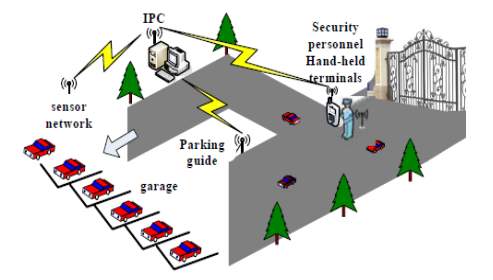
Fig. 5 Smart parking
2.3.5 SMART WATER SUPPLY: Monitoring the water supply is enabled by wireless network system which helps to ensure that there is sufficient water supply for both residential and commercial use. Furthermore, it also used to determine any water losses, that is to determine the water leakage problem which helps to save the water. The system collects the data regularly of the pipe flow, also sends automatic alerts if the usage of the water is beyond of an estimated regular range. This helps the smart cities to locating the leakage in the pipes and prevents the water loss by arranging the repairs as per the priority.
2.3.6 SMART GRIDS: It is an electrical grid, which utilize the internet of things to enhance the efficiency of power transmission, improves the quality of services and decreases the potential failures. With the help of IoT in smart grids power suppliers can control the resources to provide power in proportion to the population growth as all the devices in this network which are connected with the sensor that continuously provides data of the power consumption to the central server. The server regulates the amount of power consumption which will enhance the production to meet the power needs.
2.3.7 INTELLIGENT COMMUNITY SECURITY SYSTEM: The intelligent community security (ICSS) system consists of various subsystems, such as surrounding Security Subsystem (SSS), Vehicle Management Subsystem (VMS), Property Management Subsystem (PMS), Central Information Processing System (CIPS), Fire and Theft Prevention Subsystem (FTPS), etc. The information of all the subsystems messages automatically to the CIPS wirelessly to maintain the security of community.
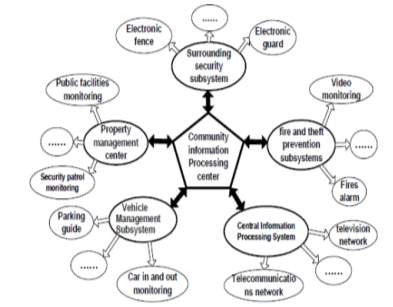
Fig. 6: Community system
3. CHALLENGES
3.1 SECURITY:
IOT (internet of things) is a virtual network of a real world in which real time interactions are done. Improvements are done in IOT from the development of initial stage, having unique characteristics, machine to machine deployment subscriptions and contexts. With this network, very operation can be done wirelessly without physical presentation of a person for a long time. While providing improvements in efficiency, a lot of problems are generated including security breach or information security. The various threats in IOT network security are divided in to three parts:
3.1.1. FRONT-END SENSORS AND EQUIPMENT: Data received in front-end sensors through built-in sensors. After receiving data, these sensors then transmit data with the help of M2M devices or modules, by the networking services of many other sensors. In this methodology, security of machines with node connectivity and business implementation is included. Perception nodes or machines are commonly distributed when the monitoring scenario is absent. Now, an intruder can access the network and can damage the network or can do any illegal action o these nodes. The possible threats are analysed with various methods and are categorised to internet threat, unauthorised access of data and denial of services.
3.1.2. NETWORK: Networks are very important in providing an interconnection capability for communication, authentic quality of services, effectiveness and thriftiness of connection in IOTs. As there are number of connection nodes and groups exists in IOTS because there are many machines are present to send data to a network congestion, it may be results in denial of services.
3.1.3. BACK-END OF IT SYSTEMS: This system requires high security and gathering, examining data in real time because it forms the gateway and middleware or the network, to increase business intelligence. In the security of IOT, there are seven main standards: privacy protection, access control, communication layer security, user authentication, data confidentiality, data integrity and availability of time.
3.2 PRIVACY:
Users privacy and protection of data is said to be one of important challenges in IOT networks. An un authorise user can steal this sensitive information by manipulate the hardware or software of these devices. For example, an unauthorised user or intruder can alter the programming of an security camera in such a way that the camera will send data to the intruder along with the legitimate server. Therefore, the devices which contain sensitive data or information are especially important to protect. there are several computing technologies are there to ensure the privacy and security including tamper-resistance modules, device integrity validations and trusted execution.
3.2.1. PRIVACY IN DEVICE: There are many problems are there in case of devices’ privacy such as privacy of the location of the device and device holder, the identification of the exact similar nature of the device (identifiability), personal information protection in case of loss and theft and protection against side channel attacks.
3.2.2. PRIVACY DURING COMMUNICATION: Encryption is the most common operation which is done to ensure the privacy of data during the transmission of data or communication. In encryption a addition data is added to the data packet which helps in tracing, e.g. security parameter index, sequence number etc. This addition data is important for linking packets of the same flow traffic to the analysis.
3.3 POWER CONSUMPTION: To minimise power consumption is the greater challenge in machine-to-machine uses of IOT. Powering IOT could become a serious problem, when the number of users or devices will increase to billions and batteries consumed. The huge amount of real-time information is captured by the connected devices which are growing in number and are used daily by the users.
3.4 DATA CENTRE NETWORK: The other challenge is bandwidth consumption for the connectivity of IOT in addition to the power and CPU problems. The current data centre Wide Area Network (WAN) links are built for the simple or moderate bandwidth requirements created by our existing use of technology. As the number o users and the amount of data being transferred is assumed to be increase vastly, as billions of IOT devices are sending signals to the server on a network. Due to this, the requirement for the bandwidth will grows dramatically. According to the research, due to the result of all these, the data will no longer be economically feasible to store at one location.
3.5 DATA MINING: From a complex sensing bulk data at a temporal resolution, extracting useful and required information is a very challenging problem in artificial intelligence research. In current research processes, a predefined data anomalies and events are extracted from the bulk by using supervised and un supervised learning processes. In the next level learning, various methods are involved like inferring local activities from the shallow learning and temporal information extracting from it. To detect complex events which are based on longer temporal scales and larger spatial on two levels before is covered in the ultimate vision. How to simultaneously observe the representations of various events and activities at the multiple complexity levels is the fundamental research problem which comes is the complex sensing data of this nature. IN the field of deep learning, the focus is on the machine learning, in which the given data is interpreted by learn multiple layers of abstraction. Moreover, in terms of the adaptive, incremental and distributed learning techniques the sensor networks create bigger challenges in deep learning processes.
3.6 ENVIRONMENTAL CHALLENGE: Developments in IOT has also brought a large amount of challenges for the environment. The first problem faced by the people is electrical and electronic equipment’s waste problem. In upcoming years’ hundreds and thousands of IOT devices will come in the market and the old not IOT ready devices may be end up in the landfills. By the year of 2013, there was already 53 tons of elections and electrical waste deposits worldwide. with the increasing speed of IOT development, this number is assumed to be accelerate hugely. This problem needs to be take seriously for the sustainable development of the world.
The second main challenge is consumption of energy. Massive data centres are needed to process the functions of IOT networks. Therefore, the consumption of energy by these data centres is unexpectedly high. To produce that much energy for these data centres will provide unwanted burden on the environment. If these data centres will operate on less energy somehow, still it will be going to affect the energy sector. In addition to this, the manufacturing processes for the hundred and thousand of IOT devices also another problem on energy caused by the IOT network.
4. FUTURE WORK AND CONCLUSION
In public networks, there are four technologies has been proposed to IoT/M2M, which are associated with triple play services are shown in figure 7, these are as follows.
(1) Scalable switch: There are various traffic types, including a huge number of small data packets for IOT/M2M. These should be supported according to requested Quality of Service (QOS). Thus, virtual components consist of scalable switches is required.
(2) Optical transmission system: In the advanced stage of IOT/M2M, like CY2020, Upton 35ZB (35 X 1021B) data is generated in the world per year (by IDC 2011 Digital Universe study). Thus, the transmission capacity of the optical transmission needs to be improved. In case of optical trunk networks (core and metro networks), up to 100Gb/s per wavelength transmission capacity is provided with the help of WDM technology. On the other hand, in the case of access networks, up to 10Gb/s per user interface transmission capacity is provided by PON (Passive Optical Network) technology.
(3) Software pluggable gateway: As user selects and subscribes some services according to his wish. Here, many software modules, e.g., service, driver, protocol, etc. are needed. These all modules need be downloaded to the Gateway. These software modules should be downloaded to TV, STB, PC etc, as virtual gateway, in a case, if Gateway is not a dedicated component.
(4) Wireless access: Wireless access networks is required for an easy installation. There are several benefits of these wireless networks, such as these wireless access network requires low power consumption, are of low cost and long reach by multi-hop protocol. For these purposes, there is a great need of development of integrated device incorporating RF, ASIC, CPU for protocol processing.
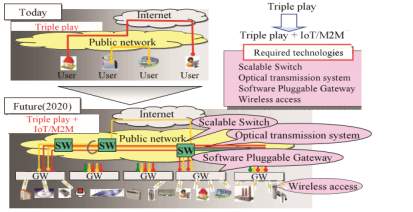
Fig. 7: proposed technologies
In this report, we had discussed about IoT and optical sensors, applications and some security and privacy issues related to Internet of Things (IoTs) by describing some challenges. The explanation of the Internet of Things (IOT) is done by the companies and various organisations in various ways, but IoT can be described as an ecosystem of technologies which is there for monitoring the status of the physical objects in the networks It captures the meaningful data and transmit that information to the software applications through IP networks. The basic objects in the definitions of the IOT includes smart objects, RF technologies, machine to machine communication and a central hub of information. In IOT, although there is a large amount of developments are done, but there are still many problems exist in the network which needs further study to resolve. The main operation of IOT is to provide services and applications. The progress and development of IOT requires extensive research in this field by scientific researchers. All the countries need to promote this research and provide their support in all the aspects according to their ability. This is the only is way which can bring bright future and to achieve this new idea of IOT worldwide.
REFRENCES
[1] G. Wen, S. Wang, Y. Mu and J. He, “The Optical Communication System of the Wild Internet of Things for One-to-Multi-Points,” 2012 Symposium on Photonics and Optoelectronics, Shanghai, 2012, pp. 1-4.
[2] T. Yokotani, “Application and technical issues on Internet of Things,” The 10th International Conference on Optical Internet (COIN2012), Yokohama, Kanagawa, 2012, pp. 67-68.
[3] P. N. Ji and Ting Wang, “Internet of things with optical connectivity, networking, and beyond,” 2016 21st Opto Electronics and Communications Conference (OECC) held jointly with 2016 International Conference on Photonics in Switching (PS), Niigata, Japan, 2016, pp. 1-3.
[4] D. P. Van, B. P. Rimal, J. Chen, P. Monti, L. Wosinska and M. Maier, “Power-Saving Methods for Internet of Things over Converged Fiber-Wireless Access Networks,” in IEEE Communications Magazine, vol. 54, no. 11, pp. 166-175, November 2016.
[5] I. Fujimori, M. Brox, E. Alon, P. Hanumolu, G. den Besten and H. Nosaka, “F4: Emerging short-reach and high-density interconnect solutions for internet of everything,” 2016 IEEE International Solid-State Circuits Conference (ISSCC), San Francisco, CA, USA, 2016, pp. 502-505.
[6] R. Munoz et al., “The CTTC 5G End-to-End Experimental Platform: Integrating Heterogeneous Wireless/Optical Networks, Distributed Cloud, and IoT Devices,” in IEEE Vehicular Technology Magazine, vol. 11, no. 1, pp. 50-63, March 2016.
[7] Jingran Luo, Yulu Chen, Kai Tang and Junwen Luo, “Remote monitoring information system and its applications based on the Internet of Things,” 2009 International Conference on Future BioMedical Information Engineering (FBIE), Sanya, 2009, pp. 482-485.
[8] D. Liu and Q. Sun, “Fibre-optic internet of things (FIOTs),” 2010 23rd Annual Meeting of the IEEE Photonics Society, Denver, CO, 2010, pp. 226-227.
[9] Kai Zhang, Dahai Han and Hongping Feng, “Research on the complexity in Internet of Things,” 2010 International Conference on Advanced Intelligence and Awarenss Internet (AIAI 2010), Beijing, China, 2010, pp. 395-398.
Cite This Work
To export a reference to this article please select a referencing stye below:
Related Services
View allRelated Content
All TagsContent relating to: "Internet of Things"
Internet of Things (IoT) is a term used to describe a network of objects connected via the internet. The objects within this network have the ability to share data with each other without the need for human input.
Related Articles
DMCA / Removal Request
If you are the original writer of this dissertation and no longer wish to have your work published on the UKDiss.com website then please:




